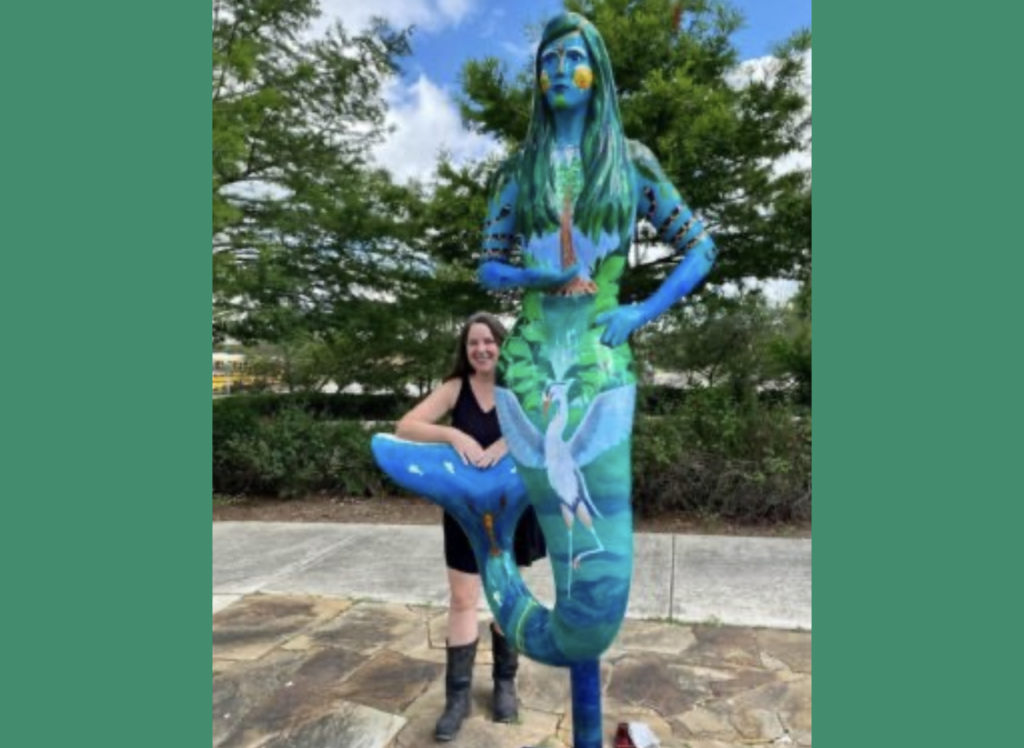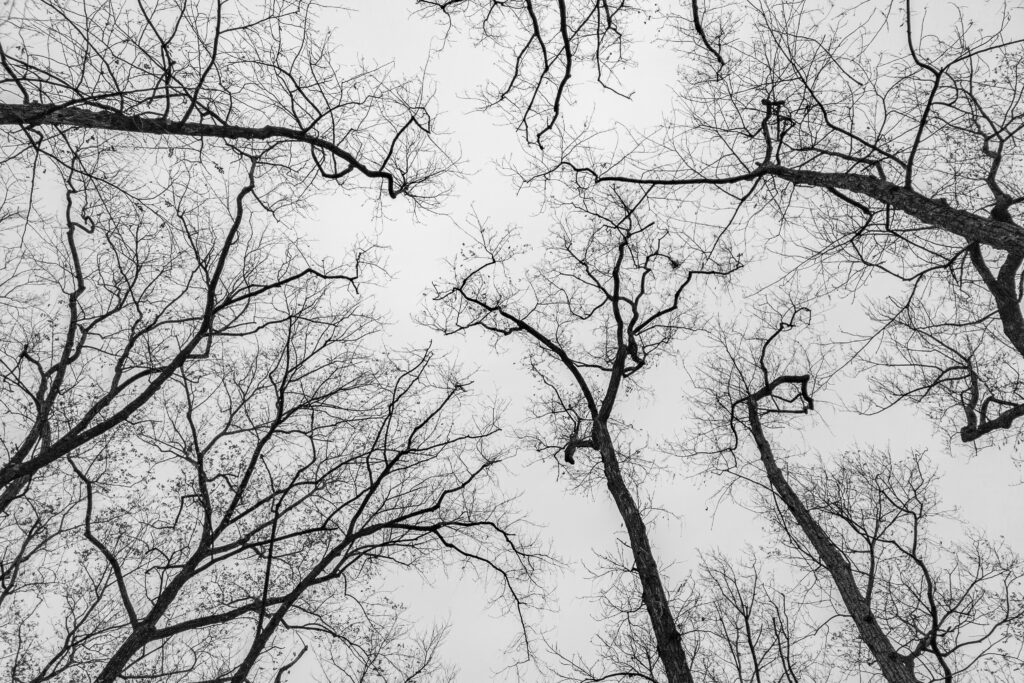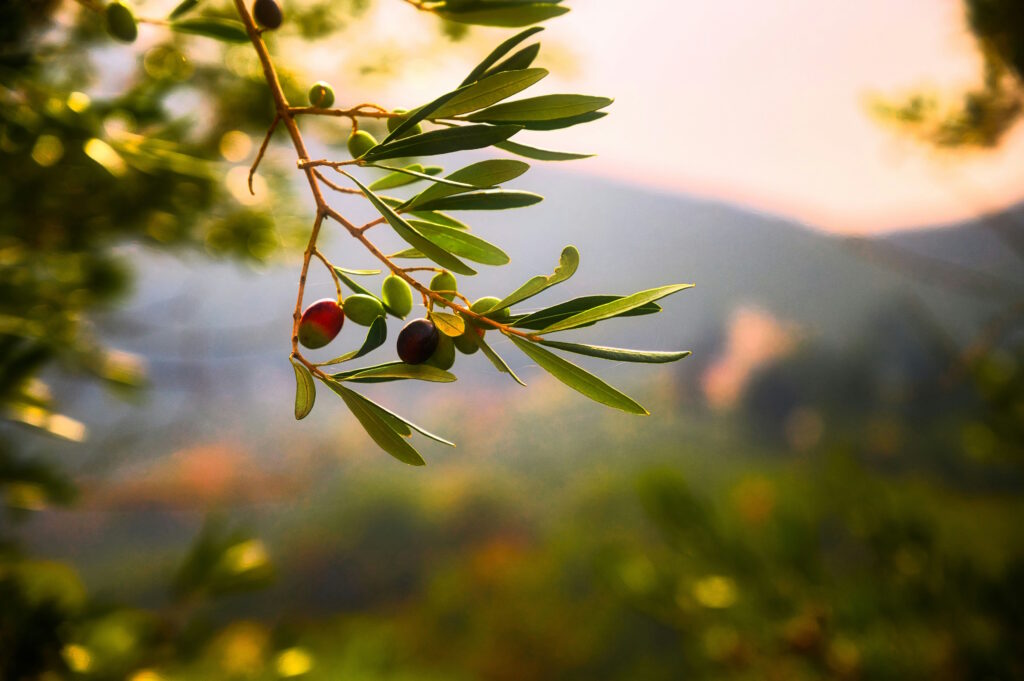Mermaids, All Shapes and Sizes: An Interview with Jamie Kimmel Shelton

Jamie Kimmel Shelton is a multimedia artist from Austin, Texas, now residing in the Mermaid Capital of Texas, San Marcos. Perhaps you have seen her work around town. She was one of ten artists chosen to collaborate in The Mermaid March, a public art project that celebrates the culture, history, and beauty of San Marcos. Kimmel Shelton’s mermaid statue, “Aqua Reina,” is a tribute to the San Marcos River and its diverse, delicate wildlife, complete with arms made of catfish and sunfish for cheeks. I was lucky enough to talk with the artist about “Aqua Reina,” merhorses, the Mermaid Society, mythology, art, and much more.
Naomi Wilson: My first question for you is just on your background. Where did you grow up? How did you get into a life of art?
Jamie Kimmel Shelton: Here’s my history in a nutshell: I grew up in Austin. I went to elementary, junior, high school all through there, but an interesting fact is my mom decided to go back to school when I was in fifth grade. She came to what was then Southwest Texas State University, now Texas State. While my mother was a student, I got to know the people in the art department at Texas State. I had always been interested in art. I started drawing animals when I was three years old, and since then I always knew I wanted to be an artist. Because I knew the faculty in the art department, I ended up coming to San Marcos for my undergraduate work. There was an advantage in that. The department does not have a graduate program, it is strictly an undergrad program, and so they treat their students like grad students. It is a very, very, very good art department. Always has been, and still is.
NW: Did you have a specific area of study when you were in school?
JKS: Yes, I was a studio artist and I didn’t really know what I wanted to do going into it. I just knew I wanted to be an artist. I enjoyed drawing and painting and all those kinds of classes, but I was, surprisingly, specifically drawn to metalsmithing. It was partly because of the teacher, Beverley Penn. She’s still teaching at Texas State, and she was just an incredible mentor and artist, and free-thinker. She helped me discover who and what I was. I graduated with a Bachelor of Fine Arts in metalsmithing. After I graduated, I also got a Bachelor of Arts in English.
NW: What inspired you to take on this line of work and who are some of your artistic influences?
JKS: As I mentioned, I started drawing animals when I was three years old. Both of my parents are trained biologists. My father went back to school, got his degree in geography, and taught at Texas State while I was there. Our family trips were always about going to natural parks, national parks, state parks and, you know, “What is that tree? What is that geographical formation? What is that animal?” I’ve been surrounded by art and nature all my life. My main influence is nature. I love animals, so that is my primary focus. Even though in school you go off in different directions and you kind of try different things, I’ve always been drawn to naturalistic elements, which has always been present in my work.
As far as influences go, there’s an artist named Deborah Butterfield, whom I love. She makes driftwood sculptures of horses, and she has always been a big influence. Then there is a glass artist named William Morris, who did incredible installations. The works of his that I love most are recreations of artifacts, archaeological burials, and things you would find in an archeological dig, like a mastodon tusk bed with a glass skeleton laying across it. Incredible, incredible recreations of anthropology and archaeology and paleontology and things like that.
NW: Would you say mythology and history are big influences for you as well?
JKS: Yes, my interest runs from mythology to archaeology to paleontology to animals. All of that ties together because so much of mythology is about animals. My favorite thing in the world is to travel, to go to archaeological ruins and see the artwork. One of my earliest travels was to Mexico to teach in Itza in the Yucatan Peninsula. The Mayan artwork there, of the jaguars and the feathered serpent, Quetzalcóatl, all of those things are mixed in my work for sure.
NW: What’s your connection to the myth and the lore of San Marcos’ mermaids? Is it something that you grew up with or something that developed over time?
JKS: My interest in mermaids is more of an interest in merhorses. Horses are one of my primary subjects. I can do them in my sleep. That’s kind of always my fallback imagery, horses. When I was growing up in Austin, we used to go to a church that was off of the University of Texas campus. There is a sculpture on the south side of the UT campus, a sculpture of Poseidon in his chariot being pulled by these merhorses, or the hippocampus, to use their mythology name. They have mermaid-like tails, a horse body, and then they have these sort of webbed hooves, so they can swim.
Another connection is coming down to Aquarena Springs back in the day when it was an amusement park where the Meadow Center is now, and there was a submarine theater in Spring Lake. You would go into the submarine and it would lower down under the surface of the water where they had women dressed up as mermaids, and they would drink a Coke underwater or have a picnic. They had Ralph the Swimming Pig and Glurpo the Clown. It was this cheesy roadside attraction because this was before I-35 was here.
That park is one of the reasons why the Mermaid Society was created. July Moreno, the founder of the mermaid society, grew up here in San Marcos so of course, Aquarena Springs was part of her heritage. When it closed in 1994, the university bought it and began turning it back into an ecological tourist destination, as opposed to an amusement tourist destination. For people who live here in San Marcos, it was a big part of their childhood and the history of this town. So, July Moreno wanted to bring that mermaid back in remembrance.
When I was chosen as one of the 10 artists to paint the big mermaid statues around town, I was trying to reconcile what the mermaid is doing in San Marcos, and I realized…geology. I’m a fossil hunter, that’s my other favorite thing to do, which ties in with animals and archaeology. And this whole area, all of Texas, was an ancient ocean. 65 million years ago, we were underwater. So that is my take on the mermaid in San Marcos. The mermaid is the perfect amalgamation of community and nature. You have the human’s upper part, which is community. Then you have the animal’s lower part, which is nature. So you can call her a mermaid, or if you think of this as having been an ancient ocean, you can call her an aqua-maid, a river guardian. That’s how the mermaid works for me. Community and river.
NW: Would you say that your art and involvement in the community have inspired others, maybe younger generations? If so, how?
JKS: I hope so. I certainly hope so. One of the ways is the mermaid I was asked to paint, which was a wonderful project to be involved in. When we first started this project, we were shown a picture of the mermaid, what she was going to look like, and we had to do our designs based on that. We didn’t have a scale. So, we all thought that they were going to be about five feet tall, which is what most of those fiberglass statues are in other towns. Then they deliver this nine-foot-tall mermaid to my house, and I’m like, “What do I do with this monster?” She had a 200-pound base that she sits on. Somehow we got the base inside. Fortunately, I have a two-story house and I was able to hoist her up to the second-story landing, put the base under her, and then drop her back on. She sat in my kitchen for three months while I painted her, my monster mermaid.
That piece is all animals. It was all the animals of the river, the animals of the environment she’s made up of. Her shoulders are turtles, her eyebrows are blind salamanders, and her cheeks are sunfish. That is what I hope will inspire the next generation and kids, to see these artworks that are on display. Public art is super important because not everybody can go to a museum, not everybody can go to the university to see the work. San Marcos has embraced public art recently with the mural projects, and with the mermaid statues and things like that. Now, kids can go see those and garner a sense of wonder, or a sense of wanting to find out more, and that means we’ve done our job.
NW: What other ways do you participate in the San Marcos community?
JKS: Well, as of June, I am the new Art Director for the Mermaid Society.
NW: Congratulations!
JKS: Thank you. Thank you. I’m excited about it. We just had our first artists’ reception. I have been in charge of revamping what had been the Mermaid Market at Wonder World Park, which is the other amusement park in town. It is now the Mermaid Capital of Texas Gift Shop and Gallery. It has local artists and global artists, but primarily local, and it’s all handmade. It’s a lovely San Marcos kind of gift shop gallery. So, I’ve been in charge of that.
What I was just coming back from was a meeting with July, the head of the Mermaid Society SMTX. We are creating an art park at Wonder World. There’s a whole side area and they are allowing us to do this art installation, and we have six different phases that we’re wanting to do with this. One of them is going to be an interactive art exhibit where people can come and be a part of it. I’m throwing myself full force into helping the Mermaid Society achieve some of its artistic goals, so some other fun ideas will be coming soon.
NW: How did you first begin working with the Mermaid Society SMTX?
JKS: Well, I’ve known about them for a long time. They were one of the supporters of the mermaid statues for one thing, and they have a big festival every year, which is coming up on September 25, the Mermaid Promenade. They’re doing a street festival for this year, but in previous years, they weren’t able to do it this year or the prior year, but they host an art ball. It is one of the most fun things I have ever been involved with. It’s usually the night before the parade, and it is intended to showcase art of all kinds. There’s live music and usually a fashion show. People dress up like you wouldn’t believe. I mean, mermaid head-to-tail. Just crazy, cool stuff. I’m also a professional belly dancer, have been for 25 years, and I have danced at the art ball since its beginning. That has been my main participation with the Mermaid Society up until I got involved with their art directorship.
NW: At Porter House Review, we love a good storyteller. Your artwork contains many stories of its own. In what way have you felt like or you know, been a storyteller in your life in your profession?
JKS: It’s very interesting because that’s something that my father is passionate about, storytelling. He’s a geographer, I mentioned. But he also created the Nature and Heritage Tourism program at Texas State, a minor in the geography department. His thing is interpretation. That’s what park rangers do: they often have degrees in interpretation. You’re interpreting nature for the visitors. It’s all about the story. It’s all about how you tell the story of a landscape, or historical elements, in the best way to help people be able to understand it. The story is extremely important.
Most of the time, I think artwork does tell its own story, in its own right. I don’t have to do a lot to give it a background, because people will bring their own story to it, which is important. I also think that an artist has to have a good concept of what they’re trying to say, even if it’s extremely personal. But that story is what viewers will connect with and take away with them. My artwork before this has been about mythology. The point of that is to try to remind people of our connection to ancient stories. My husband, he’s a mythologist and a writer, and his interest is retelling ancient wisdom in a contemporary interpretation. The story of our mythologies, of our past, of our wisdom, needs to be told in a more contemporary way so we don’t forget those stories.
NW: What’s the story behind the name of your statue, “Aqua Reina”?
JKS: When I was presented with the idea of applying for this, I had to kind of wrap my head around the mermaid thing, and the idea of her being made of the animals of the river is what worked for me. As I said, she’s got turtles for her shoulders and her arms are catfish. Her hands are the fins of the catfish. ‘Aqua Reina’, “queen of the waters” in Spanish, is an homage to Aquarena Springs, but she is also the river’s guardian. She is the river. I went deeper into my studies and looked beyond just the blind salamander, the catfish, and the things that we know of. Of course, my list also started to include the Cypress trees and the waterfall and the herons and the vulture. She started to develop into this amalgamation of all of the natural elements. That came together on her tail. It looks decorative, but they’re little snails all across the flukes of her tail. In her hair is wild rice and of course, the Gaillardia, the Indian Blankets.
NW: That’s a lot of research and brainstorming.
JKS: Those things, they sometimes just create themselves. I’ve noticed when an artwork is good, it will just sort of create itself. You’re just the conduit.
NW: What advice do you have for those wishing to follow a similar career path?
JKS: Go to art school. Go to art school, or, you know, take any community classes that you can find. One of the things that are amazing about humans is our artistic talents, and everybody has them. There’s an unfortunate thing that happens around the age of 10, 11, 12. Most of the time kids are totally fine with just drawing and having fun drawing. There comes a point in mental development where, all of a sudden, we want it to look like the thing we’re trying to draw. If it’s not, without the proper encouragement and education, at that very moment people just give up. We need to be encouraged to push past that point where we’re getting frustrated with stuff.
It doesn’t matter what age you come to it. If you can, find some way to get a little education, a little technique. If you can, find a class or a friend, somebody who is willing to give you some direction. There are thousands of YouTube videos out there that you could watch. Just stick with it a little bit. Push past the discomfort. It will grow into something
NW: I agree. And finally, who is your favorite mermaid of all time?
JKS: I guess I sort of answered this with my merhorse story, but if I had to pick another, Ursula. Mermaids come in all shapes and sizes.
Featured Photo by Tyler Sutter.


